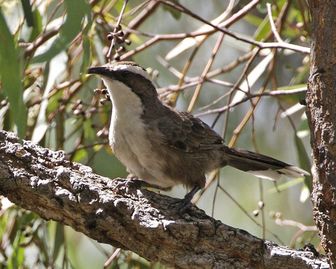White-browed Babbler
Its natural habitat is Mediterranean-type shrubby vegetation.

Original source: Lip Kee YapPermission(Reusing this file)This image, which was originally posted to Flickr.com, was uploaded to Commons using Flickr upload bot on 23:33, 22 August 2009 (UTC) by Attis1979 (talk). On that date it was licensed under the license below. This file is licensed under the Creative Commons Attribution-Share Alike 2.0 Generic license.You are free:to share – to copy, distribute and transmit the work
Author: Lip Kee YapPermission(Reusing this file)This image, which was originally posted to Flickr.com, was uploaded to Commons using Flickr upload bot on 23:33, 22 August 2009 (UTC) by Attis1979 (talk). On that date it was licensed under the license below. This file is licensed under the Creative Commons Attribution-Share Alike 2.0 Generic license.You are free:to share – to copy, distribute and transmit the work
The White-browed Babbler is classified as Least Concern. Does not qualify for a more at risk category. Widespread and abundant taxa are included in this category.
Image: White-browed Babbler at nest - Add comment Add tags White-browed Babbler at nest Description White-browed Babbler, Pomatostomus superciliosus, at nest. More
White-browed Babblers build communal roosting nests of twigs and sticks, usually in dead or partly living trees. They participate in activities such as dust-bathing, preening and feeding as a group. Alternative Name/s Chatterer, Cackler, Yahoo Identification The White-browed Babbler is a small dark brown-grey bird with a white throat, a white tipped tail and a long, pointed curved bill. It has a distinct white brow and dark eye stripe. More
White-browed Babbler at nest. White-browed Babbler at nest. Photo: Purnell Collection © Australian Museum White-browed Babbler. White-browed Babbler. Photo: K Vang and W Dabrowka © Bird Explorers Distribution map of Pomatostomus superciliosus Distribution map of Pomatostomus superciliosus Map © Birds Australia Birdata Did you know? White-browed Babblers build communal roosting nests of twigs and sticks, usually in dead or partly living trees. More
The White-browed Babbler (Pomatostomus superciliosus) is a species of bird in the Pomatostomidae family. It is endemic to Australia. Its natural habitat is Mediterranean-type shrubby vegetation. References - * BirdLife International 2004. Pomatostomus superciliosus. 2006 IUCN Red List of Threatened Species. Downloaded on 26 July 2007. Stub icon This songbird-related article is a stub. You can help Wikipedia by expanding it. More
White-browed Babblers are another of my favourite birds. Sociable, always busy, make strange friendly noises ... and hard to catch. So this morning I was fortunate and early enough to corner a gaggle of them (they travel and live in groups of around 12 or more) still in relaxed mode and took the opportunity to get some shots. For babblers, these are not-often seen moments. More
both White-browed Babbler and Grey-crowned Babbler in the same area. We continued on past Alston for nearly 3km and saw a flock of Masked Woodswallows. Jacksons Well (S27° 18´ 50" E118° 00´ 38") - The well is a very good place to look for Bourke's Parrot plus Mulga Parrot coming in to drink. Jacksons Well to Homestead (S27° 18´ 54" E117° 59´ 16") - A White-browed Treecreeper flew across the Cogla Downs road in September 1997. More
White-browed Babblers are active, noisy birds, usually found in small groups busily foraging on the ground for spiders, insects, seed and other prey or food. Both sexes have a similar appearance and breed in small groups. Babblers roost together at night in nests in the upper branches of woodland trees like Mulgas and Myalls. Distribution of the White-browed Babbler in Australia. More
The White-browed Babbler (Pomatostomus superciliosus) is endemic to Australia where it favors Mediterranean-type shrubby vegetation. - Photo, Video and/or Article contributions are welcome! Please click here for info The Avianweb strives to maintain accurate and up-to-date information; however, mistakes do happen. If you would like to correct or update any of the information, please send us an e-mail. More
m, whereas White-browed Babblers crossed gaps of at least 270 m wide. For each species, the rate of dispersal mortality per unit distance traveled was about the same. Because we have effectively partitioned the risk of dispersal mortality from the chance of outside dispersal, and because our mortality estimates are model dependent but landscape independent, they can be transported to other landscapes on which simulations have been run and, therefore, can be used in population viability assessment of unstudied or hypothetical animal populations. More
White-browed Babblers like dense, shrubby habitat like this mallee in western NSW. Photo: 445205 445205 Previous 1 2 Next Return to Photo Library page Home | Biography | Equipment | Photo library | Contact Copyright More
We first spotted White-browed Babblers on the northern edge of Jack's Creek State Forest, 20 km south of Narrabri, New South Wales, where we saw them infrequently in the years 2003-2006. Also spotted regularly since February 2008 in Deriah Forest, 30 km east of Narrabri. Spotted by us in December 2008 at Porcupine Reserve in Gunnedah, NSW. More
This White-browed Babbler indeed have some striking features and one can easily see where it names derives from. It surely is a pretty bird and the combination of brown and white feathers are really beautiful. I like the "cap" on its head formed by the patch of brown feathers very much. Thanks for sharing this image with lovely natural colours, in both the bird and its surrounding. Best regards. More
Family : Pomatostomidae
Genus : Pomatostomus
Species : superciliosus
Authority : (Vigors & Horsfield, 1827)
